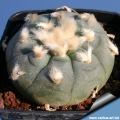




Your support is critical to our success.
Accepted Scientific Name: Lophophora williamsii (Lem. ex Salm-Dyck) J.M.Coult.
Contr. U.S. Natl. Herb. 3: 131. 1894
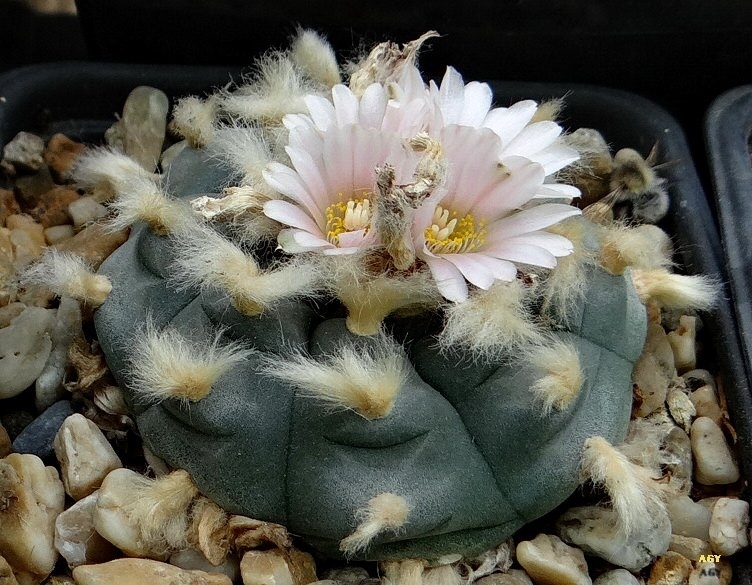
Origin and Habitat: Grows in an area that stretches from from the Chihuahuan Desert to the South Texas Plains, on either side of the middle and lower Rio Grande River, southward to the Mexican states of Chihuahua, Coahuila, Durango, Nuevo León, San Luis Potosí, Tamaulipas, Zacatecas. Extensive stands of peyote occur on the low, rocky hills in Starr, Zapata, Webb, and Jim Hogg counties of southern Texas.
Altitude: It grows from 100 up to 1900 metres above sea level.
Habitat and Ecology: This geophytic, button-like cactus occurs in xerophyllous scrub including Tamaulipan thorn scrub isolated or in groups usually in calcareous deserts, on rocky slopes, or in dried river beds. The species is very abundant in habitat with large number of mature individuals however many subpopulations of Lophophora williamsiiSN|1117]]SN|1117]] are heavily harvested in the wild throughout the range of the species, some to the point of extirpation. In Mexico, collection is illegal and people are punished for collecting it. Land use change for agriculture is a significant threat, as the land is completely ploughed, thus eliminating all vegetation including L. williamsii and its seed bank.
Synonyms:
- Lophophora williamsii (Lem. ex Salm-Dyck) J.M.Coult.
- Anhalonium visnagra K.Schum.
- Anhalonium williamsii (Salm-Dyck) Rümpler
- Anhalonium williamsii Lem. ex Förster
- Ariocarpus williamsii (Salm-Dyck) Voss
- Echinocactus lewinii (Henn. ex Lewin) K.Schum. in Engl. & Prantl
- Echinocactus williamsii Lem. ex Salm-Dyck
- Echinocactus williamsii var. anhaloninicus K.Schum.
- Echinocactus williamsii var. pellotinicus (K.Schum.) Rouhier
- Mammillaria williamsii (Lem.) J.M.Coult.
Lophophora williamsii (Lem. ex Salm-Dyck) J.M.Coult.
Contr. U.S. Natl. Herb. 3: 131. 1894
Synonymy: 34
- Lophophora williamsii (Lem. ex Salm-Dyck) J.M.Coult.
- Anhalonium visnagra K.Schum.
- Anhalonium williamsii (Salm-Dyck) Rümpler
- Anhalonium williamsii Lem. ex Förster
- Ariocarpus williamsii (Salm-Dyck) Voss
- Echinocactus lewinii (Henn. ex Lewin) K.Schum. in Engl. & Prantl
- Echinocactus williamsii Lem. ex Salm-Dyck
- Echinocactus williamsii var. anhaloninicus K.Schum.
- Echinocactus williamsii var. pellotinicus (K.Schum.) Rouhier
- Mammillaria williamsii (Lem.) J.M.Coult.
- Lophophora williamsii var. echinata (Croizat) Bravo
- Lophophora echinata Croizat
- Lophophora williamsii var. fricii f. cristata hort.
- Lophophora williamsii var. fricii f. variegata hort.
- Lophophora williamsii subs. grymi Halda, J.Kupčák & Sladk.
- Lophophora williamsii var. heptagona Y.Itô
- Lophophora williamsii var. jourdaniana (Haberm.) hort.
- Anhalonium jourdanianum Lewin
- Echinocactus jourdanianus Rebut ex C.A.Maass
- Lophophora jourdaniana Haberm.
- Lophophora williamsii var. lewinii (Henn. ex Lewin) J.M.Coult.
- Anhalonium lewinii Henn. ex Lewin
- Lophophora lewinii (Henn.) Rusby
- Mammillaria lewinii (Henn. ex Lewin) H.Karst.
- Lophophora williamsii var. pentagona Croizat
- Lophophora pentagona (Croizat) V.Gapon
- Lophophora williamsii var. pluricostata Croizat
- Lophophora pluricostata (Croizat) V.Gapon
- Lophophora williamsii var. texana Frič ex Kreuz.
- Lophophora lutea var. texana (Frič ex Kreuz.) Backeb.
- Lophophora williamsii var. typica Croizat
Lophophora williamsii var. caespitosa Y.Itô
1952 (nom. inval)
Accepted name in llifle Database:
Lophophora williamsii var. caespitosa f. variegata hort.
Accepted name in llifle Database:
Lophophora williamsii var. cristata Houghton
J. Cact. Succ. Soc. Amer. 2: 490. 1931
Accepted name in llifle Database:
Lophophora williamsii var. fricii (Haberm.) Grym
Rod Lophophora 56 1997
Synonymy: 8
- Lophophora williamsii var. fricii (Haberm.) Grym
- Anhalonium floro rosea Frič
- Lophophora diffusa subs. fricii (Haberm.) Halda
- Lophophora fricii Haberm.
- Peyotl zacatensis (Haberm.) Sotom., Arred. & Mart.Mend.
- Peyotl zacatensis var. fricii (Haberm.) Sotom., Arred. & Mart.Mend.
- Lophophora fricii var. decipiens (Croizat) P.Hansen
Lophophora williamsii f. variegata hort.
Cultivars (2):
ENGLISH: Medicine of God, Devil’s root, Divine herb, Dry whiskey, Cactus pudding, Devil's-root, Diabolic-root, Divine cactus, Dry-whiskey, Dumpling cactus, Indian-dope, Mescal-buttons, Turnip cactus, Peyote, Pellote, Mescal Buttons, Whiskey cactus, White-mule
BASQUE (Euskara): Peiote
BULGARIAN (Български): Пейот
CATALAN (Català): Peiot
CHINESE (中文): 烏羽玉
CZECH (Čeština): Peyotl
DANISH (Dansk): Elefantfodkaktus
DUTCH (Nederlands): Peyote, Peyotl
ESTONIAN (Eesti): Peioote-uimakaktus
FINNISH (Suomi): Myrkkykaktus, Meskaliinikaktus
FRENCH (Français): Peyotl, Peyote
GALICIAN (Galego): Peyote
HEBREW (עברית): פיוטה
HUICHOL: Hikuri
HUNGARIAN (Magyar): Peyotl, Peyote, Meszkalinkaktusz, Pejot
ITALIAN (Italiano): Peyote, Mescal
JAPANESE (日本語): ウバタマ, ペヨーテ
KOREAN (한국어): 페요테
LATVIAN (Latviešu): Peijots
LITHUANIAN (Lietuvių): Kvaitulinis pejotlis
MACEDONIAN (Македонски): Пејот
NAHUATL (Nāhuatl): Peyōtl
NORWEGIAN (Bokmål): Peyote
POLISH ( Polski): Jazgrza Williamsa
PORTUGUESE (Português): Peiote
RUSSIAN (Русский): Пейо́тль, Пейо́т, Лофофора Уильямса
SLOVENIAN (Slovenščina): Pejotl
SPANISH (Español): Peyote, Mescal
SWEDISH (Svenska): Peyote
TARAHUMARA: Híkuri wanamé, Híkuli wanamé
Description: Lophophora williamsiiSN|1117]]SN|1117]] is a solitary or (rarely) caespitose, spineless cactus, normally unicephalous but becoming polycephalous with age or injury,
Stem: Glaucous green, dull bluish or greyish green, very succulent, globular, top-shaped, or somewhat flattened up to 6 cm tall, 12 cm diameter, with a woolly top; The subterranean portion of the stem, which is as wide as the aerial portion, extends several cm below the surface of the ground and transitions smoothly (through a thin hypocotyl) into a large taproot which may extend over 25 cm below ground level.
Ribs: (5 when young) 7 to 13 (very rarely 4 or 14 ) broad, rounded, straight, or spiralled, often tuberculate, sometimes irregular and indistinct, with transverse furrows forming more or less regular, polyhedral tubercles;
Roots: Napiform, usually 8-11 cm long
Areoles: Round spineless, bearing flowers only when young with some bunches of long erect, matted, wooly greyish hairs, up to 1 cm long.
Flowers: Solitary, campanulate, 1.5-2.5 cm across when open usually pink (rarely whitish) outer perianth segments and scales ventrally greenish. They emerge from the mass of hairs at umbilicate centre of crown each surrounded by a mass of long hairs. Stigma-lobes 5-7, linear, pink.
Blooming season: Flowers sporadically throughout summer.
Fruits: Club-shaped, red to pinkish, 2 cm long or shorter which can be very delectable and sweet-tasting when eaten.
Seeds: Small and black up to1 mm in diameter, with broad basal hilum, tuberculate-roughened.
Subspecies, varieties, forms and cultivars of plants belonging to the Lophophora williamsii group
 Lophophora fricii var. decipiens (Croizat) P.Hansen: With the exception of the smaller and more pale pink flowers, its appearance corresponds to the appearance of Lophophora Fricii.
Lophophora fricii var. decipiens (Croizat) P.Hansen: With the exception of the smaller and more pale pink flowers, its appearance corresponds to the appearance of Lophophora Fricii. Lophophora williamsii (Lem. ex Salm-Dyck) J.M.Coult.: Globular or somewhat flattened glaucous green or greyish green spineless cactus up to 6 cm tall, 12 cm diameter, with a woolly top; It has a large taproot which may extend over 25 cm below ground level.
Lophophora williamsii (Lem. ex Salm-Dyck) J.M.Coult.: Globular or somewhat flattened glaucous green or greyish green spineless cactus up to 6 cm tall, 12 cm diameter, with a woolly top; It has a large taproot which may extend over 25 cm below ground level. Lophophora williamsii var. caespitosa Y.Itô: This name is used to indicate a number of clones of horticultural origin characterized by a more or less accentuated production of axillary shoots that in age grow and form huge cushions.
Lophophora williamsii var. caespitosa Y.Itô: This name is used to indicate a number of clones of horticultural origin characterized by a more or less accentuated production of axillary shoots that in age grow and form huge cushions. Lophophora williamsii var. caespitosa f. variegata hort.: variegated form.
Lophophora williamsii var. caespitosa f. variegata hort.: variegated form. Lophophora williamsii var. cristata Houghton: There is an impressive array of cristates which forms glaucous green, dull bluish or greyish green, very succulent contorted and convoluted brain-like mounds. They are some of the more striking and priced crested cacti.
Lophophora williamsii var. cristata Houghton: There is an impressive array of cristates which forms glaucous green, dull bluish or greyish green, very succulent contorted and convoluted brain-like mounds. They are some of the more striking and priced crested cacti.- Lophophora williamsii var. echinata (Croizat) Bravo
 Lophophora williamsii var. fricii (Haberm.) Grym: Beautiful variety with large intensive pink pink flowers.
Lophophora williamsii var. fricii (Haberm.) Grym: Beautiful variety with large intensive pink pink flowers. Lophophora williamsii var. fricii f. cristata hort.: crested form.
Lophophora williamsii var. fricii f. cristata hort.: crested form. Lophophora williamsii var. fricii f. variegata hort.
Lophophora williamsii var. fricii f. variegata hort. Lophophora williamsii var. fricii cv. Marbles: has wide and well developed rounded tubercles. Seems to be a pretty variable plant with several clones.
Lophophora williamsii var. fricii cv. Marbles: has wide and well developed rounded tubercles. Seems to be a pretty variable plant with several clones.- Lophophora williamsii subs. grymi Halda, J.Kupčák & Sladk.: Solitary or in group with 6-10 prominent straight ribs with low polygonal tubercles with short brownish wool. Flowers large pinkish-white.
 Lophophora williamsii var. jourdaniana (Haberm.) hort.: It has rose-violet or dark pink-red perianth, pistil and filaments with small long persisting spines on young areoles. Old plant forms a dense cluster or mound.
Lophophora williamsii var. jourdaniana (Haberm.) hort.: It has rose-violet or dark pink-red perianth, pistil and filaments with small long persisting spines on young areoles. Old plant forms a dense cluster or mound.- Lophophora williamsii var. lewinii (Henn. ex Lewin) J.M.Coult.: Long areolar hairs.
- Lophophora williamsii var. pentagona Croizat: All heads 5-ribbed.
- Lophophora williamsii var. pluricostata Croizat: Ribs always numerous.
 Lophophora williamsii var. texana Frič ex Kreuz.: (or texensis ) is the phenotype from the Texas area (USA), this local form has very grey pruinose stems with numerous flat ribs (up to 14 in adult specimens).
Lophophora williamsii var. texana Frič ex Kreuz.: (or texensis ) is the phenotype from the Texas area (USA), this local form has very grey pruinose stems with numerous flat ribs (up to 14 in adult specimens). Lophophora williamsii cv. Kikko: This odd cultivar is easily distinguishable for its ± wide and long pointed tubercles along the bumped ribs edges. Seems to be a pretty variable plant with several clones.
Lophophora williamsii cv. Kikko: This odd cultivar is easily distinguishable for its ± wide and long pointed tubercles along the bumped ribs edges. Seems to be a pretty variable plant with several clones.
Bibliography: Major references and further lectures
1) Terry, M. 2013. Lophophora williamsii. In: IUCN 2013. IUCN Red List of Threatened Species. Version 2013.2. <www.iucnredlist.org>. Downloaded on 24 February 2014.
2) Edward Anderson “The Cactus family” Timber Press, Incorporated, 2001
3) James Cullen, Sabina G. Knees, H. Suzanne Cubey "The European Garden Flora Flowering Plants: A Manual for the Identification of Plants Cultivated in Europe, Both Out-of-Doors and Under Glass" Cambridge University Press, 11/Aug/2011
4) David R Hunt; Nigel P Taylor; Graham Charles; International Cactaceae Systematics Group. "The New Cactus Lexicon" dh books, 2006
5) Edward F. Anderson “Peyote: The Divine Cactus” University of Arizona Press, 1996
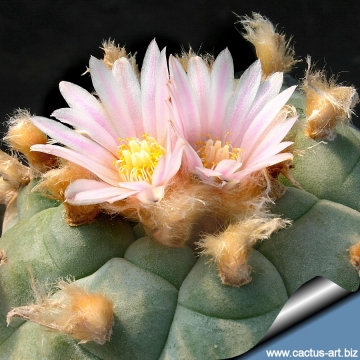
Ariocarpus williamsii (Lophophora williamsii) Photo by: Cactus Art
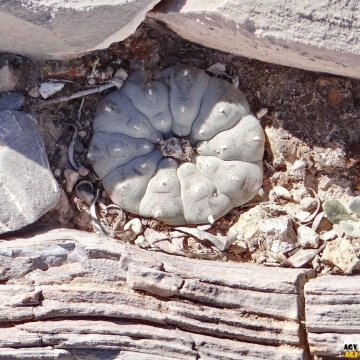
Nested in a rock crevice. Mexico. (Lophophora williamsii) Photo by: Agócs György
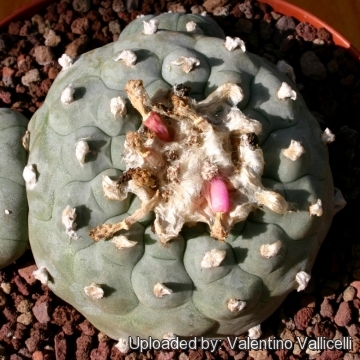
It is one of the most and ornamental cacti. (Lophophora williamsii) Photo by: Valentino Vallicelli
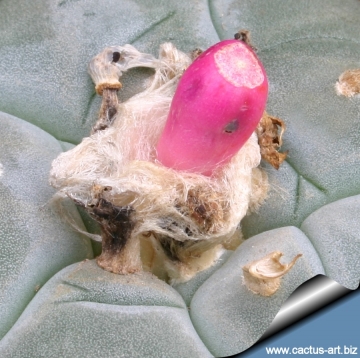
Ariocarpus williamsii (Lophophora williamsii) Photo by: Cactus Art
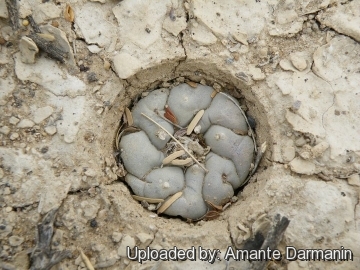
Lopophora williamsii, Approximately 32km from Estacion Marte, Coahuila (Lophophora williamsii) Photo by: Amante Darmanin
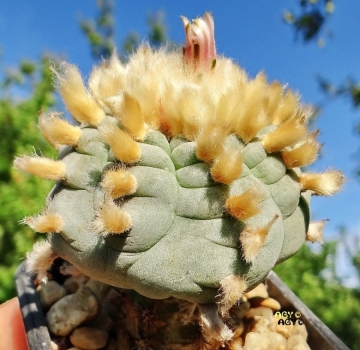
Ariocarpus williamsii (Lophophora williamsii) Photo by: Agócs György
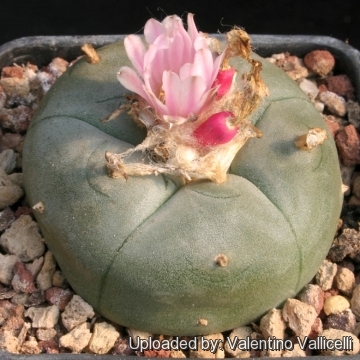
Ariocarpus williamsii (Lophophora williamsii) Photo by: Valentino Vallicelli
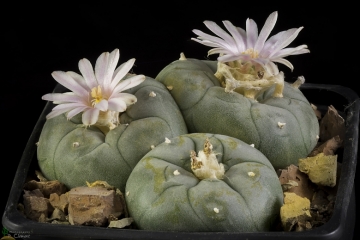
Ariocarpus williamsii (Lophophora williamsii) Photo by: Peiffer Clement
Cultivation and Propagation: All Lophophora species are extremely slow growing, often taking up to thirty years to reach flowering age in the wild (about the size of a golf ball, not including its root). Human cultivated specimens grow considerably faster, usually taking from six to ten years to go from seedling to mature flowering adult.
Because of the tap root they are very rot prone, so use highly gritty compost with much drainage. Requires half shade to part sun. Waterings should be rather infrequent to keep the plant compact and not to become excessively elongated and unnatural in appearance, watering it properly is often difficult because this plant tends to crack open or rot if over-watered. The fact that the plant retracts into the soil and assume a grey-green colouring between watering, is perfectly natural and doesn’t cause any damage.
Overwatering: Keep completely dry and cool in winter (An unheated greenhouse would be perfect) or when night temperatures remain below 10° C, it can survive low temperatures (appr. -7°C) for a short period. Assure a good ventilation.
Propagation: Easy to propagate from seeds. The seeds are, requiring hot and humid conditions to germinate.
Uses: Peyote has been used for centuries for the mystical effects experienced when it is ingested. It contains a large spectrum of phenethylamine alkaloids, the principal of which is mescaline. The top of the cactus that grows above ground, also referred to as the crown, consists of disc-shaped buttons that are cut from the roots and dried. These buttons are generally chewed, or boiled in water to produce a psychoactive tea. The resulting infusion is extremely bitter and, in most cases, the user experiences a high degree of nausea before the onset of the psychedelic effects.
However cultivated plants have only traces of the alkaloid present in wild harvested plant and their “psychedelic” effect are minimal or completely absent, but they still cause nausea, vomit, headache.
| Your Actions | |
|---|---|
| Back to Ariocarpus index | |
| Back to Cactaceae index | |
 |
Back to Cacti Encyclopedia index |
Privacy stantement - Terms and conditions - How to cite - About us - Feedback - Donate








